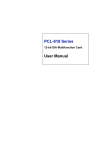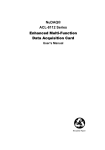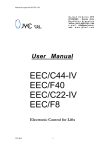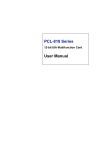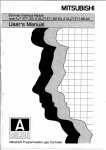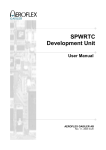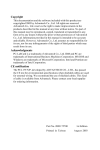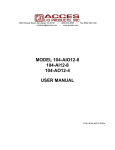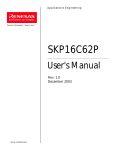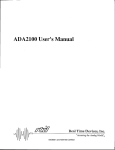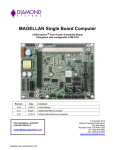Download 穨 Pcl-816
Transcript
PCL-816/814B MODULAR DA&C CARD PCL-816/814B MODULAR DA&C CARD USER'S MANUAL COPYRIGHT NOTICE This document has been copyrighted, 1994, by Advantech Co., Ltd. All rights are reserved. Advantech Co., Ltd. reserves the right to make improvements to the products described in this manual at any time without notice. No part of this manual may be reproduced, copied, translated, or transmitted in any form or by any means without the prior written permission of Advantech Co., Ltd. Information provided in this manual is intended to be accurate and reliable. However, Advantech Co., Ltd. assumes no responsibility for its use, nor for any infringements upon the rights of third parties which may result from its use. ACKNOWLEDGEMENTS PC-LabCard is a trademark of Advantech Co., Ltd. IBM and PC are trademarks of International Business Machines Corporation. MS-DOS is a trade mark of Microsoft Corporation. BASIC is a trademark of Dartmouth College. Part No. 2003816020. 2nd Edition Printed in Taiwan. Nov. 1994 TABLE OF CONTENTS CHARTER 1. QUICK START - - - - - - - - - - - - - - - - - - - - - - - - - - 1 1.1. Board Layout- - - - - - - - - - - - - - - - - - - - - - - - - - - - - - - - 1 1.2. Pin Connector Assignment - - - - - - - - - - - - - - - - - - - - - - - 2 1.3. Quick RUN- - - - - - - - - - - - - - - - -- - - - - - - - - - - - - - - - - 2 1.3.1. Factory Setting- - - - - - - - - - - - - - - - - - - - - - - - - - - 2 1.3.2. Run the PCL-TEST- - - - - - - - - - - - - - - - - - - - - - - - 3 1.4. Quick Reference for Register Format- - - - - - - - - - - - - 3 CHARTER 2. INTRODUCTION - - - - - - - - - - - - - - - - - - - - - - - - 7 2.1. General Information- - - - - - - - - - - - - - - - - - - - - - - - - - - - 7 2.2. Initial Inspection- - - - - - - - - - - - - - - - - - - - - - - - - - - - - - - 7 2.3. Specifications- - - - - - - - - - - - - - - - - - - - - - - - - - - - - - - - - 8 CHARTER 3. INSTALLATION - - - - - - - - - - - - - - - - - - - - - - - - - 11 3.1. Base Address Selection- - - - - - - - - - - - - - - - - - - - - - - - - - 11 3.2. Wait State selection- - - - - - - - - - - - - - - - - - - - - - - - - - - - - 12 3.3. Installation- - - - - - - - - - - - - - - - - - - - - - - - - - - - - - - - - - - 13 3.4. Pin and Slot Connector. Assignments - - - - - - - - - - - - - - - - 14 3.4.1. Digital I/O and Analog Input Connectors - - - - - - - - - 14 3.4.2. Piggyback Module Slot Connectors - - - - - - - - - - - - - 16 3.5. Software Disk- - - - - - - - - - - - - - - - - - - - - - - - - - - - - - - - - 21 CHARTER 4. SIGNAL CONNECTION- - - - - - - - - - - - - - - - - - - - 23 4.1. Analog Input Connection - - - - - - - - - - - - - - - - - - - - - - - - - 23 4.1.1. Differential Channel Connection - - - - - - - - - - - - - - - 23 4.2. Digital I/O Signal Connection - - - - - - - - - - - - - - - - - - - - - -23 CHAPTERER 5. ARCHITECTURE. - - - - - - - - - - - - - - - - - - - - - -27 5.1. Register Format- - - - - - - - - - - - - - - - - - - - - - - - - - - - - - 27 5.1.1. I/O Port Address Map- - - - - - - - - - - - - - - - - - - - - - 27 5.2. A/D Conversion Mode- - - - - - - - - - - - - - - - - - - - - - - - - - 41 5.3. A/D Data Format and Status Register- - - - - - - - - - - - - - - - 41 5.4. MUX Setting- - - - - - - - - - - - - - - - - - - - - - - - - - - - - - - - - 42 5.5. Gain Setting- - - - - - - - - - - - - - - - - - - - - - - - - - - - - - - - - - 43 5.6. Trigger Mode- - - - - - - - - - - - - - - - - - - - - - - - - - - - - - - - - 43 5.7. A/D Data Transfer- - - - - - - - - - - - - - - - - - - - - - - - - - - - - - 44 5.8. How to Execute an A/D Conversion - - - - - - - - - - - - - - - - - 45 i CHAPTER 6. CALIBRATION AND TEST- - - - - - - - - - - - - - - 6. 1. Frequency of Calibration- - - - - - - - - - - - - - - - - - - - - - 6.2. Required Equipment- - - - - - - - - - - - - - - - - - - - - - - - - 6.3. Calibrating the Analog Input - - - - - - - - - - - - - - - - - - - 6.3.1. Calibration Procedure - - - - - - - - - - - - - - - - - - - - 47 47 47 47 47 CHAPTER 7. TROUBLESHOOTING AND DIAGNOSIS - - - - - - 49 APPENDIX A. PROGRAMMABLE TIMER/COUNTER- - - - - - - 51 A.1. The Intel 8254- - - - - - - - - - - - - - - - - - - - - - - - - - - - - - - - 51 A.2. Counter Read/Write and Control Registers - - - - - - - - - - - - 51 A.3. Counter Operating Modes - - - - - - - - - - - - - - - - - - - - - - - - 55 A.3.1. MODE O - Stop on Terminal Count- - - - - - - - - - - - 55 A.3.2. MODE 1 - Programmable One-Shot- - - - - - - - - - - - 55 A.3.3. MODE 2 - Rate Generator (divide by N counter) - - - 55 A.3.4. MODE 3 - Square Wave Rate Generator - - - - - - - - - 56 A.3.5. MODE 4 - Software Triggered Strobe - - - - - - - - - - - 57 A.3.6. MODE 5 - Hardware Triggered Strobe- - - - - - - - - - -57 A.4. Counter Operations - - - - - - - - - - - - - - - - - - - - - - - - - - - - 57 A.4.1. Read/Write Operation- - - - - - - - - - - - - - - - - - - - - - 57 A.4.2. Counter Read-Back Command- - - - - - - - - - - - - - - - 58 A.4.3. Counter Latch Operation - - - - - - - - - - - - - - - - - - - 58 ii CHAPTER 1. OUICK START 1.1. Board Layout 1 Quick Start 1.2. Pin Connector Assignment PCL-816/814B 1.3. Quick RUN 1.3.1. Factory Setting 1.BaseAddress : 200(HEX) 2. Wait State : 0 2 PCL-816/814B 1.3.2. Run the PCL-TEST Quick Start 1. Install the PCL-816/814B in your PC. 2. Insert the Utility disk in your disk driver. 3. Run the PCLTEST.EXE. 4. Connect the signal to an analog input on CN3 (Use of Screwterminal Board PCLD-880 is recommended). 1.4. Quick Reference for Register Format 1. BASE+0 (READ/WRITE) : Digital I/O Low Byte 2. BASE+1 (READ/WRITE) : Digital I/O High Byte 3. BASE+2 : N/A 4. BASE+3 : N/A 5. BASE+4 (READ/WRITE) : 8254 Counter0 6. BASE+5 (READIWRITE) : 8254 Counter 1 7. BASES+6 (READIWRITE) : 8254 Counter2 8. BASE+7 (READIWRITE) : 8254 Control Word 9. BASE+8 READ : A/D low byte data WRITE : A/D software trig 10.BASE+9 READ : A/D high byte data 3 4 5 6 CHAPTER 2. INTRODUCTION 2.1. General Information The PCL-816/814B is a 16-bit/l4-bit multi-purpose DAS (Data Acquisition System) card. It provides great flexibility for PC-based data acquisition systems by supporting a variety of piggyback DAS modules for Digital I/O, Counter/Timer, D/A and A/D applications. The PCL-8161814B DAS card comes equipped with its own 16-bit/l4-bit A/D piggyback module. Additional modules may be purchased separately. We also provide the following special function modules: • 16-bit D/A module • 12-bit D/A module • 24-bit DI/O module • 5-channel counter/timer module 2.2. Initial Inspection As you unpack your PCL-816/814B, check to make sure that the following items have been included: 1. PCL-816/814B Modularized DAS Carrier Board 2. l6-Bit A/D Module (PCL-81601), or 14-Bit A/D Module (PCL-81401) 3. Utility diskette containing the software driver demonstration programs and language interfaces for C, C++, PASCAL and BASIC. 4. User's manual When unpacking the PCL-816/814B, be sure that you avoid contact with anything that may produce a static electrical discharge. Inspect the PCL816/814B and it’s A/D module for any defects, or for damage that may have occurred during shipping and handling. Your PCL-816/814B has been thoroughly inspected and tested before being shipped. If you find that this product is defective or incomplete in any manner, contact your authorized distributor or local dealer immediately. 7 Introduction PCL-816/814B 2.3. Specifications Analog Input: • Channels : 16 differential analog input channels • Resolution : 16 bits (PCL-816) 14 bits (PCL-814B) • Sampling rate : 100 KHz maximum • Accuracy : 0.003% FS +1 LSB (PCL-816 A/D Module) 0.003% FS +1 LSB (PCL-814B A/D Module) • Input impedance : > 10 MΩ • Connector D37 Female Connector : Programmable Input Ranges: • Bipolar PCL-816 PCL-814B : +/-10 V +/-5 V +/-2.5 V +/-1.25 V : +5 V +2.5 V +1.25 V +0.625 V • Unipolar : 0 - +10 V 0 - +5 V 0 - +2.5 V 0 - +1.25 V • Trigger mode : Software, pacer and external trigger modes available 8 PCL-816/814B Digital Input: Introduction Digital Output. 9 10 CHAPTER 3. INSTALLATION The PCL-816/814B was designed with ease of use in mind. The only parameters that have to be set are the base address and the wait state. Unlike other DA&C cards which contain many jumpers and switches that must be set manually, all hardware functions of the PCL-816/814B are software programmable. 3.1. Base Address Selection • I/O Port Address Selection It is important to select an appropriate I/O port address for the PCL-816/814B, in order to avoid conflicts which might occur during input/output operations on the PC bus. The PCL-816/814B utilizes 16 consecutive I/O address locations within the PC's bus architecture. Valid addresses (hexadecimal) range from 100 to 3FO. Some of these addresses may be used by devices which already exist on the bus. Exceptional care should therefore be exercised when selecting the appropriate I/O address for your PCL-816/814B. An eight position DIP switch, SW1, allows you to set the PCL-816/814B's I/O address (position 1 through 6). The factory default address setting is 200 (hexadecimal). The following table provides the necessary information to make an appropriate address selection (A4 through A9 correspond to the address lines of your PC bus). 11 Installation PCL-816/814B * = Factory default setting 0 = ON; 1 = OFF 3.2. Wait State selection • Wait State Selection When running certain applications, PCs which employ high-speed CPUs sometimes require additional wait states in order to insure that the data transfer rate is steady. (CPUs which run at speeds of less than 33MHz will not experience this problem. In general, the 33MHz speed will not require additional wait states.) The PCL-816/814B can be configured to accommodate 0, 2, 3 or 5 wait state delays. The length of the wait state can be selected from positions 7 and 8 on SW1. The table below provides the available wait state selections. 12 PCL-816/814B Installation * = Factory default setting 0 = ON; 1 = OFF 3.3. Installation • PCL-816/814B Installation Before installing the PCL-816/814B in the PC, make sure that the DAS modules are properly configured and installed on the carrier board. To install the PCL-816/814B, proceed as follows: 1. Make sure that your PC and peripheral devices are powered off and that their power cords have been disconnected. 2. Remove the chassis cover. 3. Locate a vacant expansion slot on your passive backplane that will accommodate the full-sized PCL-816/814B board. 4. Insert the carrier board into the expansion slot. Use the retaining bracket as a guide between the chassis rear panel and the base of the backplane. 13 Installation PCL-816/814B 5. Once the PCL-816/814B is firmly inserted into the expansion slot, secure the carrier board to the chassis by screwing down the retaining bracket to the chassis rear panel. 6. Replace the chassis cover. 7. Connect all peripheral and power cords. 8. Power on the system. Your PCL-816/814B should now be ready to run data acquisition applications. 3.4. Pin and Slot Connector Assignments The information in the following sub-sections will provide you with all pin and slot connector assignments and diagrams. You may need to refer to these subsections when connecting external devices and piggyback modules to the PCL816/814B. 3.4.1. Digital I/O and Analog Input Connectors The PCL-816/814B uses two 20-pin connectors for Digital Output (CN1) and Digital Input (CN2), and one DB-37 connector for Analog Input (CN3). Figures 3.1 and 3.2 show the pin assignments for the D/I, D/O and Analog Input connectors. Be sure to refer to these figures when connecting external devices to the PCL-816/814B. Key: (for Figure 3-1) D/O D/I DGND STROBE Digital Output Digital Input Digital Ground External signal which latches the digital input data (active low) 14 PCL-816/814B Digital Output (CNI) Installation Digital Input (CN2) Figure 3.1 Note: 1. CNI Pin 14 has two selectable outputs: one is D/O 13, and the other is Pacer Out. You can select the required output with JP1. Under normal conditions, JP1 should be set to select D/O 13. However, when the PCL-816/814B is used with Sample and Hold Board PCLD-787, JP1 should be set to select Pacer Out. 2. D/I O and Ext. Trig are located on the same pin, CN2 Pin 1. 3. D/I 1 and POE are located on the same pin, CN2 Pin 2. 15 Installation PCL-816/814B Key: (for Figure 3-2) A/D H A/D L AGND 3.4.2. Analog Input High (differential) Analog Input Low (differential) Analog ground Piggyback Module Slot Connectors The PCL-816/814B has three piggyback slot connectors (Slots 0, 1, and 2). The 72-pin connector located at Slot 0 is dedicated to the A/D module. Slots 1 and 2 are 64-pin connectors used for installing the D/A, Digital I/O, Counter/Timer, and other modules. These modules (except for the A/D module) are all interchangeable between Slots 1 and 2. The following diagrams (Figures 3.3, and 3.4) illustrate pin assignments for the slot connectors. This information is important to the operation of the PCL-816/814B DAS card, and will help you to understand its relationship with each of its piggyback modules. It is recommended that you refer to this section whenever you install and program a module. 16 PCL-816/814B Installation Key: (for Figure 3.3: slot 0 ) A/D H0 - A/D H15 A/D L0 - A/D L15 AD0 - AD15 ID0 - ID3 A-D PG0,PG1 U/B ADTRIG ADEOC AGND DGAND Analog input high (differential) Analog input low (differential) A/D data bus A/D module identification code A/D channel selection Gain selection Unipolar/bipolar A/D conversion trigger pulse End of A/D conversion Analog ground Digital ground 17 Installation PCL-816/814B Slot 0 (for the A/D module only) Figure 3.3 18 PCL-816/814B Installation Key: (for Figure 3.4: Slots 1 and 2) D0 - D7 A0 - A3 SEL IOR IOW ID0 - ID7 DRQ IORY CLKPC CLK10 IRQ AGND DGND ADTRIG RESET AEN DMAEN DMACK CLR-IRQ MODULSEL Data bus Address lines Module active I/O read I/O write Module identification code DMA Request I/O channel ready Clock from PC 10 MHz clock Interrupt request Analog ground Digital ground A/D conversion trigger pulse Reset the module Address enable DMA enable DMA acknowledge Clear interrupt request Module select control 19 Installation PCL-816/814B Slots 1 and 2 (for all other modules) Figure 3.4 20 PCL-816/814B 3.5. Installation Software Disk A floppy disk containing utility software is included with each PCL-816/814B to minimize your application programming effort, and support the PCL816/814B calibration. The utility programs include: 1. A comprehensive I/O driver for A/D, D/A, Digital I/O and Counter applications. This driver allows you to use standard functions, written in common programming languages, to operate the PCL-816/814B without going into detailed register control. Languages supported by the software driver include BASICA, GWBASIC, QUICKBASIC, Microsoft C/C++ and PASCAL, Turbo C/C+ +, Borland C/C+ + and Turbo PASCAL. Please refer to the Software Drivers User's Manual for more information. 2. Demonstration programs. 3. Calibration program. 4. Test program. It is strongly recommended that you make a working copy from the master disk and save the master disk in a safe place. You may use the DOS COPY or DISKCOPY commands to copy the disk files to another floppy disk, or use the COPY command to copy the files to a hard disk. 21 22 CHAPTER 4. SIGNAL CONNECTION Correct signal connection is one of the most important factors in ensuring that your application system sends and receives data correctly. Good signal connections will avoid a lot of unnecessary problems and possible costly damage to your valuable personal computer and associated hardware. This chapter provides some useful information on signal connection arrangements in different types of data acquisition applications. 4.1. Analog Input Connection 4.1.1. Differential Channel Connection The differential input configuration has two signal wires for each channel. This type of input responds only to the voltage difference between these two wires, the High and Low inputs. If the signal source has no connection to ground, it is called a "floating source". In this case, a connection must exist between Low and Ground in order to define a common reference point. To measure a floating source, the input channel should be connected as shown below: 23 Signal Connection PCL-816/814B If the signal source has one side connected to a local ground, the signal source ground and the PCL-816/814B ground will not be at exactly the same voltage as they are connected through the ground return of the equipment and building wiring. The difference between these ground voltages forms a common mode voltage. To avoid ground loop noise effect, the signal ground should be connected to the Low input signal. The Low input should not be connected to the PCL816/814B ground directly. In some cases, a wire connection between the PCL816/814B ground and signal source ground may be necessary. The following two diagrams illustrate both the correct and incorrect connections for a differential input with a local ground. • Correct connection: • Incorrect connection: 24 PCL-816/814B Signal Connection The PCLD-774 analog expansion board is designed to accommodate multiple external signal-conditioning daughter boards, such as PCLD-779 and PCLD789. Featuring five sets of on-board 20-pin header connectors, the PCLD-774 introduces a new star-type architecture which allows cascading of multiple signal-conditioning daughter boards. The signal-attenuation and currentloading problems of normal cascading are solved by this unique arrangement. For information on these products, please contact your local PC-LabCard sales representative. 4.2. Digital I/O Signal Connection The PCL-816/814B has 16 digital input and 16 digital output channels. The digital I/O levels are TTL compatible. To transmit or receive digital signals to or from other TTL devices, the connection should be as shown: To receive an OPEN/SHORT signal from a switch or relay, a pull-up resistor must be added to ensure that the input is held HIGH when the contact is open. 25 26 CHAPTER 5. ARCHITECTURE 5.1. Register Format This section has been written for those users who wish to design their own software drivers, instead of using the one provided with the PCL-816/814B. The following table provides a summary of the port address map. The functions of each address and a detailed data format of each register are given in the following section. 5.1.1. I/O Port Address Map Module Location Selected Read Write ------------------------------------------------------BASE+0 Module-0 D/I Low Byte D/O Low Byte BASE+1 Module-0 D/I High Byte D/O High Byte BASE+2 Module-0 N/A N/A BASE+3 Module-0 N/A N/A BASE+4 Module-0 Counter 0 Counter 0 BASE+5 Module-0 Counter 1 Counter 1 BASE+6 Module-0 Counter 2 Counter 2 BASE+7 Module-0 Counter Readback Counter Control BASE+8 A/D Low Byte Software A/D Trigger BASE+9 A/D High Byte A/D Range Control BASE+10 Current Channel Status Clear Interrupt Request 27 Architecture PCL-816/814B BASE + 11 MUX Scan Channel Status Scan Channel Setting BASE + 12 Control Control BASE + 13 Status DMA/IRQ Channel Setting BASE + 14 Carrier I.D. Code Module Interrupt Mask Control BASE + 15 Module I.D. Code Module Selection 1. Digital I/O Registers (BASE+0, 1; WRITE, READ) The PCL-816/814B offers 16 digital input and 16 digital output channels. These I/O channels use the input and output ports at addresses BASE+0 and BASE+1 (Module-0). The data format of each port is as follows: * Data Format: 28 PCL-816/814B Architecture BASE+1(Write port) : D/O high byte 2. 8254 Counter Registers (BASE+4, 5, 6, 7; WRITE, READ) BASE+4 8254 Counter #O Register (Read/Write) EASE+5 8254 Counter #1 Register (Read/Write) BASE+6 8254 Counter #2 Register (Read/Write) BASE+7 Counter Read-back Register (Read) BASE+7 Counter Control Register (Write) The PCL-8161814B is equipped with an INTEL 8254 timer/counter chip. The 8254 has three counters. The PCL-816/814B uses counter #0 to generate the trigger pulse for the A/D chip. Counter #0 should be programmed as Mode 1 (one-shot mode). The following instructions are recommended: OUT BASE+7, &H32 ;Set Counter #0 as Mode 1 OUT BASE+4, &H0A ;Write low byte first OUT BASEI-4, 0 ;Write high byte (Program counter 0 as a 1 uS one-shot generator) Note: Take care to program the 8254 counter 0 exactly as described in the steps above, otherwise the PCL-816/814B will not perform the required data acquisition tasks. Counter #1 and Counter #2 are used to generate the pacer clock signal. Programming the desired pacer clock rate is a simple procedure. The following formula illustrates the pacer clock calculation: 29 Architecture PCL-816/814B Pacer rate = 10MHz/(C1*C2) Where: C1 = 16-bit data for Counter 1, Ranges 2 to 65535. C2 = 16-bit data for Counter 2, Ranges 2 to 65535. The manufacturer recommends using the following programming instructions with the pacer clock rate: OUT BASE+7, &H76 OUT BASE+S, C1_Low OUT BASE+S, C1_High OUT BASE+7, &HB6 OUT BASE+B, C2_Low OUT BASE+6, C2_High ;Set Counter #1 as Mode 3 ;Write C1's low byte ;Write C1's high byte ;Set Counter #2 as Mode 3 ;Write C2's low byte ;Write C2's high byte *** For more information about programming the Intel 8254 timer/counter, please refer to Appendix A. 3. A/D Data Registers (BASE+8, 9; READ) * Data Format: 30 PCL-816/814B 4. Architecture Software A/D Trigger (BASE+8; WRITE) Any value written to the register BASE+8 will trigger the A/D module, causing one data conversion. * Please refer to Base+12 for Trigger Mode Setting. 5. A/D Range Control (BASE+9, WRITE) * Data Format: 31 Architecture PCL-816/814B PCL-816 16-BIT MODE CODING FORMAT ( FS = Full Scale Range) When using our PCL-81401 14 Bit A/D Module, the data format for the A/D Range Control byte is as follows: 32 PCL-816/814B Architecture Note: 1. When you want to assign the gain setting for a channel, you must use Base+11 to assign the channel first. 2. For PCL-814B, unipolar and bipolar inputs cannot be mixed in autochannel scan mode. Input must be either all bipolar or unipolar. 33 Architecture PCL-816/814B 6. Current A/D Channel Configuration Register (BASE+10; READ) * Data Format: BASE+10 : * Legend: UIB: 0 = Bipolar 1 = Unipolar G1, G0: Gain selection (refer to BASE+9) CN3 to CN0: Current channel number 7. Clear INT register (BASE+10; WRITE) Any value written to the register BASE+10 will clear the interrupt active flag. The PC-816/814B is then ready to accept the next interrupt request. 8. MUX Scan Register (BASE+11; WRITE, READ) * Data Format: BASE + 11 : * Legend: CH3 to CH0 - Stop scan channel number. 34 PCL-816/814B Architecture CL3 to CL0 - Start scan channel number 9. Control register (BASE+12, WRITE, READ) * Data Format: BASE+12 : * Legend: S/W = 1, S/W trig enable S/W = 0, S/W trig disable PACER = 1, PACER trig enable PACER = 0, PACER trig disable EXT = 1, EXT. trig enable EXT = 0, EXT. trig disable ( Note : EXT. trig comes from DI0 ) POE : Pacer out enable control POE = 0, Pacer enabled POE = 1, Pacer is controlled by DI1. If DI1 is connected to TTL low level, the Pacer will be held. This means that the analog source cannot go into A/D conversion. 35 Architecture PCL-816/814B Under normal conditions, DI1 will be pulled high. DMAEN : DMA transfer control DMAEN = 0, DMA transfer dis abled DMAEN = 1, DMA transfer enabled Note: When the DMA transfer function is enabled, the INT for Terminal Count (TC) only is also automatically enabled. The DMA's terminal count generates INT when the specified number of bytes have been transferred. INTE : Disable/Enable PCL-816/814B to generate interrupt. INTE = 0, disables the function of interrupts. No interrupt signal can be sent to the PC bus. INTE = 1, enables the function of an interrupt when any module sends an interrupt signal . DS1 to DS0 - DMA Source Selected 0 0 : A/D module 0 1 : Piggyback Module #1 1 0 : Piggyback Module #2 1 1 : invalid 36 37 Architecture PCL-816/814B BASE + 13 * Legend: DRDY : A/D Data Ready Flag of a Conversion DRDY = 1, means the A/D data has been read. DRDY = 0, means the A/D data is ready for reading. (When you read the Base+8 or Base+9, then this bit will be set to 1 until new A/D Data has been loaded). INTACT : Interrupt active flag INTACT = 0, means the PCL-816/814B has not generated an interrupt. If the INT function is enabled, then this function will be waiting for an interrupt. INTACT = 1, means that if the PCL-816/814B generates an interrupt, then this bit will be set to 1. INTACT must be cleared to 0 before accepting the next interrupt. This is accomplished by writing any value to base +10 of the PCL-816/814B. You can find the interrupt source by way of reading ISI, IS0 (Interrupt Source ID Code). IS1, IS0 : Interrupt source ID code. 00 01 10 11 : : : : Slot 0 Slot 1 Slot 2 DMA (TC) CN3 to CN0 : Next channel to be converted. 38 PCL-816/814B Architecture 12. Carrier Board ID Code Register (BASE+14, READ) * Data Format BASE+14 : You can get the Carrier Board ID Code by reading BASE+14 twice. If on the first reading, the byte you got was 81 (HEX), then the second byte will be 60 (HEX). On the other hand, if the first byte you got was 60 (HEX), then the second byte will be 81 (HEX). 13. Module Interrupt Mask Setting (BASE+14, WRITE) * Data Format BASE + 14 : * Legend : M0 : Slot 0 interrupt mask bit. M0 = 0, Slot 0 interrupt function enabled. M0 = 1, Slot 0 interrupt function disabled. M1 : Slot 1 interrupt mask bit. M1 = 0, Slot 1 interrupt function enabled. M1 = 1, Slot 1 interrupt function disabled. 39 Architecture PCL-816/8I4B M2 : Slot 2 interrupt mask bit. M2 = 0, Slot 2 interrupt function enabled. M2 = 1, Slot 2 interrupt function disabled. 14. Module ID Code Register (BASE+15, READ) * Data Format: BASE + 15 : * Legend: ID3 to ID0 - Active module identify code. 40 PCL-816/814B Architecture 15. Module Selection register (BASE+15, WRITE) The Module Select register is a write-only register using address BASE+1S. This register can select the active module on the PCL-816/814B. * Data Format: BASE+15 : S1 S0 Selected Module -----------------------------0 0 On board A/D module 0 1 GP Module 1 1 0 GP Module 2 1 1 Not available 5.2. A/D Conversion Mode This section provides a complete explanation of how to use the PCL-8161814B A/D conversion functions. The following topics are covered: A/D data format, input range selection, MUX multiplexer channel control, trigger modes and data transfer. 5.3. A/D Data Format and Status Register An 8 bit register is too small to accommodate 16/14 bit A/D conversions performed by the PCL-816/814B. This problem is solved by storing A/D data in two 8-bit registers located al addresses BASE +8 and BASE +9. The A/D low byte data are located in positions D0 (AD0) through D7 (AD7) of BASE f8. A/D high byte data are located in positions D0 (AD8) through D7 (AD15) of BASE +9. The least significant bit is AD0, and the most significant bit is AD15. 41 42 PCL-81 6/814B 5.5. Gain Setting Architecture * Data Format : BASE+B 5.6. Trigger Mode The PCL-816/814B A/D conversions can be triggered in any one of three ways: software trigger, on-board programmable pacer or external pulse trigger. Each is explained below: 1. Software trigger This feature is controlled by software commands issued by the application program. Writing to register BASE +8 with any value causes a software trigger to be executed. This mode is not normally used in high speed A/D applications, due to the short execution times of the application programs. 2. On-board programmable pacer The PCL-816/814B incorporates the INTEL 8254 Programmable Interval Timer/Counter. In the pacer trigger mode, Counters 1 and 2 of the INTEL 8254 are configured as one pacer, offering precisely timed A/D converter trigger pulses. Speeds range between 0.5 MHz and 35 minutes per pulse (For details on how to use the INTEL 8254 timer/counter, please refer to Appendix A). The pacer trigger mode is ideal for interrupt and DMA data transfer, which is normally used in A/D applications requiring high conversion speeds. 3. External pulse trigger The PCL-816/814B direct external trigger pulses are controlled through EXT.TRG (connector CN2 DI0). This mode is used mostly in A/D applications requiring A/D conversions which are not measured 43 Architecture PCL-816/814B periodically. Instead, they are measured conditionally (e.g., in thermocouple temperature control). 5.7. A/D Data Transfer There are three possible ways to execute the PCL-816/814B A/D data transfer: (1) Program control (2) Interrupt routine and (3) Direct memory access. 1. Program control The program control method of data transfer uses the "polling" concept, in which each device is checked to see if data is to be transferred. After the A/D converter has been triggered, the application program checks the data ready (DRDY) bit of BASE + 13. If the DRDY bit is 0, the converted data is moved from the A/D data register to computer memory by application program control. 2. Interrupt routine When employing the interrupt routine method of transfer, data is sent from the A/D data registers to a previously defined memory segment by the interrupt service routine. At the start of each conversion, the A/D Trigger signal generates an interrupt which enables the interrupt service routine to perform the transfer. Before using this interrupt routine, the following parameters must be specified: a. The interrupt control bit of the control register (BASE +12). b. The IRQ level selection BASE +13. A write action to the A/D status register address (BASE +10) with any value resets the PCL-816/814B interrupt request and re-enables the PCL816/813B interrupt. 3. Direct memory access (DMA) DMA transfers A/D data from the PCL-816/814B hardware device to the PC system memory without operating the system CPU. DMA is very useful in high speed data transfer, but is complicated to operate. It is necessary to 44 PCL-816/814B Architecture set the DMA channel selection (BASE +13), the DMA enable bit in the PCL-816/814B control register (BASE +12) and the 8237 DMA controller registers before performing DMA operations. We recommend that the PCL-816/814B software driver be used for DMA operation. For more information regarding DMA operations, please refer to any data book for the 8237 DMA controller. 5.8. How to Execute an A/D Conversion I/O port instructions used by D&A programs may be written either directly or by first invoking the PCL-816/814B driver. The latter approach is recommended, as it enhances program performance and makes programming easier. In the last section of this chapter, step-by-step implementation procedures for different AD operations are outlined. Data transfer using the methods of pacer trigger and program control may be accomplished without the PCL-816/814B driver, as follows: Step 1 : Set the input channel by specifying the Mux scan range. Step 2 : Write the pacer trigger mode to the control register, Base + 12. Step 3 : Wait for the DRDY by reading the BASE +13 register DRDY bit. Step 4 : Read data from the A/D converter by reading the A/D data registers (BASE +8 and +9). Step 5 : Convert data by converting the binary A/D data to an integer. 45 46 CHAPTER 6. CALIBRATION AND TEST 6.1. Frequency of Calibration Since every card is thoroughly tested and calibrated in our factory, your new PCL-816/814B should not require calibration before initial use. Under normal conditions, a calibration should be performed every 6 months to one year; if, however, frequent variations in temperature or humidity are common, recalibrate at least once every three months. 6.2. Required Equipment Ideally, you will need a precision voltage source and connecting cables. If you do not have a precision voltage source, our 16-Bit D/A module is recommended. 6.3. Calibrating the Analog Input The A/D is calibrated by applying a known voltage to Channel 0 and adjusting the onboard VRs (variable resistors) for gain and offset (refer to Fig 6.1 for VRs location). 6.3.1. Calibration Procedure The entire calibration procedure is included on the utility disk. The information can be accessed by running the CALB816.EXE/CALB814B.EXE file. Please refer to this automated procedure if you want to calibrate your PCL-816/814B. 47 48 CHAPTER 7. TROUBLESHOOTING AND DIAGNOSIS Should problems arise when using the PCL-816/814B MODULARIZED DA&C CARD, the following list of troubleshooting procedures should be helpful in identifying the cause and implementing a solution. ( 1) Check the PC bus power, especially the +12 volt and +5 volt supplies. (2) Check the voltage of the signal between the AIHn and AILn. This voltage should not exceed the full scale input range of the card. (3) Check the voltage between your signal ground and the card's ground. It should be 0 volts. (4) Check other boards in your PC for Address, DMA and Interrupt level conflicts. (5) Refer to our example programs on the utility disk for techniques and as a guide to check your programs again. 49 50 APPENDIX A. PROGRAMMABLE TIMER/COUNTER A.1.The Intel 8254 The PCL816/814B uses the Inlet 8254 programmable interval timer/ counter Version 2. The 8254 is a very popular timer/counter device consisting of three independent 16 bit down counters. Each counter has a clock input, control gate and an output Ii can be programmed to have a count from 2 up to 65535. The maximum clock input frequency is 10 MHz for Version 2 of the 8254. The PCL8161814B provides a 10 MHz input frequency through an on-board crystal oscillator. Counters 1 and 2 are cascaded and operated in a tired divider configuration. Counter 1 input is connected to tire 10 MHz input frequency and the output of Counter 1 is connected to the input of Counter 2. The output of Counter 2 is internally configured to provide trigger pulses to the A/D converter, but it is also available for other uses. CNI Pin 13 may he configured as either DO13 or Pacer Out by means of jumper JP1. A.2. Counter. Read/Write and Control Registers The 8254 programmable interval timer uses four registers at address BASE+4, BASE+5, BASE+6 and BASE+7. The function of each register is as follows: BASE+4 Counter 0 Read/Write BASF+5 Counter 1 Read/Write BASE+6 Counter 2 Read/Write BASE+7 Counter Control Word 51 Programmable Timer/Counter PCL-816/814B Since the 8254 counter uses a 16 bit structure, read/write data is split into the least significant byte (LSB) and the most significant byte (MSB). It is important to ensure that your read/write operations are in pairs, and to keep track of the byte order. The data format of the control register is: BASE+ 7 : Control Legend : SCI & SCO - Select Counter SC1 SC0 Counter ------------------------0 0 0 0 1 1 1 0 2 1 1 Read-back command RW1 & RW0 - Select the Read/Write operation. RW1 RW0 Operation ------------------------0 0 Counter latch 0 1 Read/Write LSB 1 0 Read/Write MSB 1 1 Read/Write LSB first, then MSB. 52 PCL-816/814B Programmable Timer/Counter M2, M1 and M0 - Select the Operating Mode. M2 M1 M0 Mode ----------------------0 0 0 0 Interrupt on terminal count 0 0 1 1 Programmable one shot X 1 0 2 Rate generator X 1 1 3 Square wave rate generator 1 0 0 4 Software triggered strobe 1 0 1 5 Hardware triggered strobe BCD - Select Binary or BCD Counting BCD Type -----------------------------0 Binary Counter 16-bits 1 Binary Coded Decimal (BCD) Counter If the module is set to binary, the count can be any number from 0 up to 65535. If the module is set to BCD (binary coded decimal), the count can be set as any number from 0 to 9999 If both the SC1 and SC0 bit are set to 1, the counter control register is in readback command. The data format of the control register then becomes: BASE+ 7 53 Programmable Timer/Counter PCL-816/814B Legend : CNT = 0 - Latch count of selected counter(s). STA = 0 Latch status of selected counter(s). C2, CI and C0 Select counter for a read-back operation C2 = 1 select Counter 2 C1 = 1 select Counter 1 C0 = 1 select Counter 0 It SCI and SC0 are both set to I and STA is set to 0. the counter read/write register selected by C2 to C0 contains the return status byte. The data format of the counter read/write register then becomes: BASE + 4/5/6 Legend: OUT - Counter output current state. NC Null count indicates when the last count written to the counter register has been loaded into the counting element. - 54 PCL-816/814B Programmable Timer/Counter A.3. Counter Operating Modes A.3.1. MODE 0 - Stop on Terminal Count The output will he initially low alter setting this mode of operation. After the count is loaded into the selected count register, the output will remain low and the counter will count. When terminal count is reached, the output will go high and will remain high until the selected counter is reloaded with the mode or a new count is loaded. The counter continues to decrement after terminal count has been reached. Rewriting a counter register during counting generates the following results. 1. 2. Write the first byte slops the current counting. Write the second byte starts the new count. A.3.2. MODE 1 - Programmable One-Shot The output will go low on the count following the rising edge of the gate input. The output will go high on the terminal count. If a new count value is loaded while the output is low, it will not affect the duration of the one-shot pulse until the succeeding trigger. The current count can be read at any time without affecting the one-shot pulse. The one-shot is re-triggerable, thus the output will remain low for the frill count after any rising edge on the gate input. A.3.3. MODE 2 – Rate Generator (divide by N counter) The output will he low for one period of the input clock The period from one output pulse to the next equals the number of input counts in the counter register. If the counter register is reloaded between output pulses, the present period will not be affected, but the subsequent period will reflect the new value. 55 Programmable Timer/Counter PCL-816/814B The gate input, when low, will force the output high. When the gate input goes high, the counter will start from the initial count. Therefore the gate input can be used to synchronize the counter. When this mode is set, the output will remain high until the count register is loaded. The output can also be synchronized by software. A.3.4. MODE 3 - Square Wave Kate Generator Mode 3 is similar to Mode 2, except that the output will remain high until one half the count has been completed (for even numbers), and will go low for the other half of the count. This is accomplished by decrementing the counter by two on the falling edge of each clock pulse. When the counter reaches the terminal count, the state of the output is changed, the counter is reloaded with the full count and the whole process is repeated. If the count is odd and the output is high, the first clock pulse (after the count is loaded ) decrements the count by 1. Subsequent clock pulses decrement the count by 2. After timeout, the output goes low and the full count is reloaded. The first clock pulse (following the reload) decrements the counter by 3. Subsequent clock pulses decrement the count by two until timeout. Then the whole process is repeated. In this way, if the count is odd, the output will he high for (N+1)/2 counts and low for (N-1)/ 2 counts. 56 PCL-816/814B Programmable Timer/Counter A.3.5. MODE 4 - Software Triggered Strobe After the mode is set, the output will be high. When the count is loaded, the counter will begin counting. On terminal count, the output will go low for one input clock period, after which it will again go high. If the count register is reloaded during counting, the new count will be loaded on the next CLK pulse. The count will be inhibited while the GATE input is low. A.3.6. MODE 5 - Hardware Triggered Strobe The counter will start counting after the rising edge of the trigger input and will go low for one clock period when the terminal count is reached. The counter is retriggerable A.4. Counter Operations A.4.1. Read/Write Operation For each counter, the type of read/write operation, operating mode and counter type must all be properly specified in the control byte, and the control byte must be written before the initial count is written. Since the control byte register and all three counter read/write registers have separate addresses, and each control byte specifies the counter it applies to (by SC1 & SC0), no instructions on the operating sequence are required. Any programming sequence following the 8254 conventions is acceptable. There are three types of counter operation: read/load LSB, read/load MSB and read/load LSB followed by MSB. It is important to ensure that your read/write 57 Programmable Timer/Counter. PCL-816/814B operations are in pairs, and to keep track or the byte order. A.4.2, Counter Read-Bark Command The 8254 counter read-back command allows users to check the count value, programmed mode, and current states of the OUT pin and Null Count flag of the selected counter(s). The command is written into the control word register and has the format shown in Section 8.2. The read-back command may be used to latch multiple counter output latches by setting the CNT bit = 0 and selecting the desired counter(s) This single command is functionally equivalent to several counter latch commands, one for each counter latched. The read-back command can also be used to latch status information of the selected counter(s) by setting STA hit = 0. Status must be latched to be read; the status of a counter is accessed by a read from that counter. The counter status format is shown in Section 8.2 A.4.3. Counter Latch Operation It is often desirable to read the value of a counter without disturbing the count in progress. Usually the method used is the counter latch command method, which allows the user to read the latched count value of the selected counter. The 8254 supports counter latch operations in two ways. The first way is to set RW1 & RW0 to (0.0), which latches the count of the selected counter in a 16 bit hold register. The second approach is performing latch operation under the read-back command by setting SCI & SC0 to(l,l)and CNT = 0, This method has the advantage of operating several counters at the same lime. A subsequent read operation on the selected counter will retrieve the held value. 58






























































